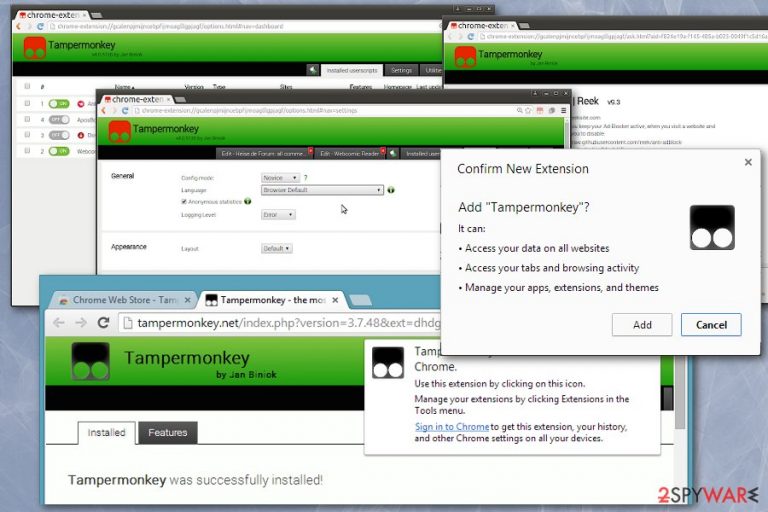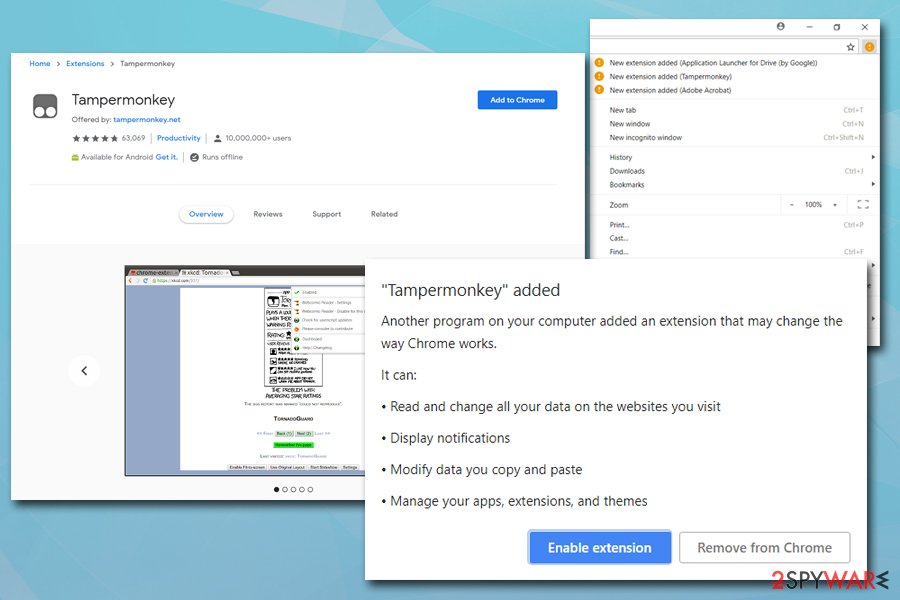Tampermonkey (Removal Instructions) - updated Aug 2019
Tampermonkey Removal Guide
What is Tampermonkey?
Tampermonkey is a Google Chrome and other browser extension that helps users modify the functionality of the visited site

Tampermonkey is a userscript managing application that is usually downloaded intentionally for Chrome, MS Edge, Firefox, Safari, and Opera web browsers. The extension is widely popular, residing in more than 10 million users computers due to its useful functionality – it allows modification of certain visited website function modifications which would otherwise be unavailable.
Tampermonkey allows users to choose from more than 400,000 different JavaScript[1] scripts that each is used for different functions. For example, “Auto Close YouTube Ads” script allows the automatic closure of the ad as soon as the “Skip ad” option becomes available, while “Anti-Adblock Killer” prevents websites from blocking the feature. This is how Tampermonkey add-on can make the online experience of many users much more efficient – it provides many customization options.
However, like many browser extensions, Tampermonkey is not without the problems. First of all, while the application is itself safe, it might, potentially, load unsafe scripts from unknown sources. Loading outside scripts might be just as dangerous as downloading an executable from Torrent sites. Besides, some users complained about Tampermonkey removal and self-reinstallation problems.
| Name | Tampermonkey |
|---|---|
| Type | Browser extension |
| Developed by | Jan Biniok |
| Purpose | Allows users to load additional scripts that changes the functionality of various websites |
| Distribution | Official sources, third-party sites |
| Potential dangers | Downloading and installing malicious scripts for the app that could result in malware infection and unwanted browser behavior |
| Fix | If you experience any suspicious behavior like reinstallation of the app, scan the system using FortectIntego or another security software |
While Tampermonkey is a useful app with plenty of customization options, it might sometimes not be safe. However, it all depends on how users use it, as loading malicious scripts without realizing it is also a possibility. Malicious scripts can abuse the vulnerabilities of the web browsers, installed programs, or the operating system. For that reason, malware[2] installation might be performed automatically, without user consent.
Most of such JavaScripts are embedded on hacked or malicious websites. Unfortunately, scripts for Tampermonkey might be hosted on malicious sites that users might download intentionally, thinking it is legitimate. Therefore, the reckless behavior can indeed lead to malware.
Please pay attention to the description of what Tampermonkey app can do:
Add “Tampermonkey”?
It can:
Read and change all your data on the websites you visit
Display notifications
Modify data you copy and paste
Manage your apps, extensions, and themes
If you combine these permissions with a malicious script that you might have downloaded, the consequences might be devastating.

To make sure that your computer is safe, we recommend scanning it with anti-malware software like FortectIntego or SpyHunter 5Combo Cleaner, especially if you noticed strange browser behavior – redirects, excessive ads, extensions installed without your consent, or overall slowness of the computer operation.
Another problem that prompted users to call the extension “Tampermonkey virus” is its reinstallation problems. Several users claimed that even after getting rid of the application, it gets reinstalled as soon as the browser is restarted.[3] Some also stated that after such installation, they were unable to remove Tampermonkey, as the option was missing entirely.
To get rid of Tampermonkey, you should check our guidelines below. In the worst-case scenario, the reinstallation of the browser might be required.
Potentially unwanted software come without users' knowledge
Automatic (re)installation of browser extensions might not necessarily be related to the extensions themselves, but rather with installed potentially unwanted programs[4] on the machine. In most of the cases, such unwanted apps like adware come bundled with freeware or shareware.
These free programs are usually hosted on third-party sites. While there is nothing illegal about offering several applications via the installer, some of these optional components might be ad-sponsored and even malicious. Therefore, it is especially important to make sure the installation process of new applications is performed as carefully as possible. Here are some experts' tips[5] on the matter:
- Before installing the app, check out its reviews online – they can often hint if the program is shady;
- Choose reliable sources for your downloads. While all third-party sites bundle software, they do perform security checks before offering them;
- During the installation process, decline all deals/offers;
- Check for fine print and pre-ticked boxes;
- When prompted, always opt for Advanced/Custom settings.
Terminate suspicious processes and uninstall Tampermonkey
In some cases, Tampermonkey removal might be hindered by another malicious application that is installed on your machine – that is when the suspicious reinstallation cycle might be observed by users. In such a case, it is vital to locate and terminate all the PUPs and malware that might be hiding on your machine.

You should first check the installed program list via the Programs and Features (Windows) or Applications (Mac) folders and uninstall everything suspicious. Then, make sure you reset each of the installed browsers – the action is mandatory to prevent altered settings from returning the unwanted activity of the PUP. Finally, you should scan your machine with anti-malware software to make sure your computer is secure.
In some cases, all these actions might be not enough to remove Tampermonkey. The underlying reason might be modified registry or other vital operating system parts. In such a case, experts recommend reinstalling the browser altogether and then performing a repeated security scan.
You may remove virus damage with a help of FortectIntego. SpyHunter 5Combo Cleaner and Malwarebytes are recommended to detect potentially unwanted programs and viruses with all their files and registry entries that are related to them.
Getting rid of Tampermonkey. Follow these steps
Uninstall from Windows
You can eliminate Tampermonkey from the device with this guide:
Instructions for Windows 10/8 machines:
- Enter Control Panel into Windows search box and hit Enter or click on the search result.
- Under Programs, select Uninstall a program.

- From the list, find the entry of the suspicious program.
- Right-click on the application and select Uninstall.
- If User Account Control shows up, click Yes.
- Wait till uninstallation process is complete and click OK.

If you are Windows 7/XP user, proceed with the following instructions:
- Click on Windows Start > Control Panel located on the right pane (if you are Windows XP user, click on Add/Remove Programs).
- In Control Panel, select Programs > Uninstall a program.

- Pick the unwanted application by clicking on it once.
- At the top, click Uninstall/Change.
- In the confirmation prompt, pick Yes.
- Click OK once the removal process is finished.
Delete from macOS
Remove items from Applications folder:
- From the menu bar, select Go > Applications.
- In the Applications folder, look for all related entries.
- Click on the app and drag it to Trash (or right-click and pick Move to Trash)

To fully remove an unwanted app, you need to access Application Support, LaunchAgents, and LaunchDaemons folders and delete relevant files:
- Select Go > Go to Folder.
- Enter /Library/Application Support and click Go or press Enter.
- In the Application Support folder, look for any dubious entries and then delete them.
- Now enter /Library/LaunchAgents and /Library/LaunchDaemons folders the same way and terminate all the related .plist files.

Remove from Microsoft Edge
Delete unwanted extensions from MS Edge:
- Select Menu (three horizontal dots at the top-right of the browser window) and pick Extensions.
- From the list, pick the extension and click on the Gear icon.
- Click on Uninstall at the bottom.

Clear cookies and other browser data:
- Click on the Menu (three horizontal dots at the top-right of the browser window) and select Privacy & security.
- Under Clear browsing data, pick Choose what to clear.
- Select everything (apart from passwords, although you might want to include Media licenses as well, if applicable) and click on Clear.

Restore new tab and homepage settings:
- Click the menu icon and choose Settings.
- Then find On startup section.
- Click Disable if you found any suspicious domain.
Reset MS Edge if the above steps did not work:
- Press on Ctrl + Shift + Esc to open Task Manager.
- Click on More details arrow at the bottom of the window.
- Select Details tab.
- Now scroll down and locate every entry with Microsoft Edge name in it. Right-click on each of them and select End Task to stop MS Edge from running.

If this solution failed to help you, you need to use an advanced Edge reset method. Note that you need to backup your data before proceeding.
- Find the following folder on your computer: C:\\Users\\%username%\\AppData\\Local\\Packages\\Microsoft.MicrosoftEdge_8wekyb3d8bbwe.
- Press Ctrl + A on your keyboard to select all folders.
- Right-click on them and pick Delete

- Now right-click on the Start button and pick Windows PowerShell (Admin).
- When the new window opens, copy and paste the following command, and then press Enter:
Get-AppXPackage -AllUsers -Name Microsoft.MicrosoftEdge | Foreach {Add-AppxPackage -DisableDevelopmentMode -Register “$($_.InstallLocation)\\AppXManifest.xml” -Verbose

Instructions for Chromium-based Edge
Delete extensions from MS Edge (Chromium):
- Open Edge and click select Settings > Extensions.
- Delete unwanted extensions by clicking Remove.

Clear cache and site data:
- Click on Menu and go to Settings.
- Select Privacy, search and services.
- Under Clear browsing data, pick Choose what to clear.
- Under Time range, pick All time.
- Select Clear now.

Reset Chromium-based MS Edge:
- Click on Menu and select Settings.
- On the left side, pick Reset settings.
- Select Restore settings to their default values.
- Confirm with Reset.

Remove from Mozilla Firefox (FF)
Don't forget to clean the browser after Tampermonkey uninstallation:
Remove dangerous extensions:
- Open Mozilla Firefox browser and click on the Menu (three horizontal lines at the top-right of the window).
- Select Add-ons.
- In here, select unwanted plugin and click Remove.

Reset the homepage:
- Click three horizontal lines at the top right corner to open the menu.
- Choose Options.
- Under Home options, enter your preferred site that will open every time you newly open the Mozilla Firefox.
Clear cookies and site data:
- Click Menu and pick Settings.
- Go to Privacy & Security section.
- Scroll down to locate Cookies and Site Data.
- Click on Clear Data…
- Select Cookies and Site Data, as well as Cached Web Content and press Clear.

Reset Mozilla Firefox
If clearing the browser as explained above did not help, reset Mozilla Firefox:
- Open Mozilla Firefox browser and click the Menu.
- Go to Help and then choose Troubleshooting Information.

- Under Give Firefox a tune up section, click on Refresh Firefox…
- Once the pop-up shows up, confirm the action by pressing on Refresh Firefox.

Remove from Google Chrome
Change settings to default on your Chrome, to make sure it normally works:
Delete malicious extensions from Google Chrome:
- Open Google Chrome, click on the Menu (three vertical dots at the top-right corner) and select More tools > Extensions.
- In the newly opened window, you will see all the installed extensions. Uninstall all the suspicious plugins that might be related to the unwanted program by clicking Remove.

Clear cache and web data from Chrome:
- Click on Menu and pick Settings.
- Under Privacy and security, select Clear browsing data.
- Select Browsing history, Cookies and other site data, as well as Cached images and files.
- Click Clear data.

Change your homepage:
- Click menu and choose Settings.
- Look for a suspicious site in the On startup section.
- Click on Open a specific or set of pages and click on three dots to find the Remove option.
Reset Google Chrome:
If the previous methods did not help you, reset Google Chrome to eliminate all the unwanted components:
- Click on Menu and select Settings.
- In the Settings, scroll down and click Advanced.
- Scroll down and locate Reset and clean up section.
- Now click Restore settings to their original defaults.
- Confirm with Reset settings.

Delete from Safari
Remove unwanted extensions from Safari:
- Click Safari > Preferences…
- In the new window, pick Extensions.
- Select the unwanted extension and select Uninstall.

Clear cookies and other website data from Safari:
- Click Safari > Clear History…
- From the drop-down menu under Clear, pick all history.
- Confirm with Clear History.

Reset Safari if the above-mentioned steps did not help you:
- Click Safari > Preferences…
- Go to Advanced tab.
- Tick the Show Develop menu in menu bar.
- From the menu bar, click Develop, and then select Empty Caches.

After uninstalling this potentially unwanted program (PUP) and fixing each of your web browsers, we recommend you to scan your PC system with a reputable anti-spyware. This will help you to get rid of Tampermonkey registry traces and will also identify related parasites or possible malware infections on your computer. For that you can use our top-rated malware remover: FortectIntego, SpyHunter 5Combo Cleaner or Malwarebytes.
How to prevent from getting browser plugins
Choose a proper web browser and improve your safety with a VPN tool
Online spying has got momentum in recent years and people are getting more and more interested in how to protect their privacy online. One of the basic means to add a layer of security – choose the most private and secure web browser. Although web browsers can't grant full privacy protection and security, some of them are much better at sandboxing, HTTPS upgrading, active content blocking, tracking blocking, phishing protection, and similar privacy-oriented features. However, if you want true anonymity, we suggest you employ a powerful Private Internet Access VPN – it can encrypt all the traffic that comes and goes out of your computer, preventing tracking completely.
Lost your files? Use data recovery software
While some files located on any computer are replaceable or useless, others can be extremely valuable. Family photos, work documents, school projects – these are types of files that we don't want to lose. Unfortunately, there are many ways how unexpected data loss can occur: power cuts, Blue Screen of Death errors, hardware failures, crypto-malware attack, or even accidental deletion.
To ensure that all the files remain intact, you should prepare regular data backups. You can choose cloud-based or physical copies you could restore from later in case of a disaster. If your backups were lost as well or you never bothered to prepare any, Data Recovery Pro can be your only hope to retrieve your invaluable files.
- ^ Jay Sridhar . What Is JavaScript and How Does It Work?. MakeUseOf. Technology, Simplified.
- ^ Malware. Wikipedia. The free encyclopedia.
- ^ My google crome have added to extensions "tampermonkey" and "totakrecipesearch" without my consent. Google. Support forums.
- ^ Potentially Unwanted Programs slow down your system and can be harmful: Here’s what can you do about it. Emsisoft. Straight-talking security advice.
- ^ Virukset. Virukset. Spyware related news and virus removal guides.
